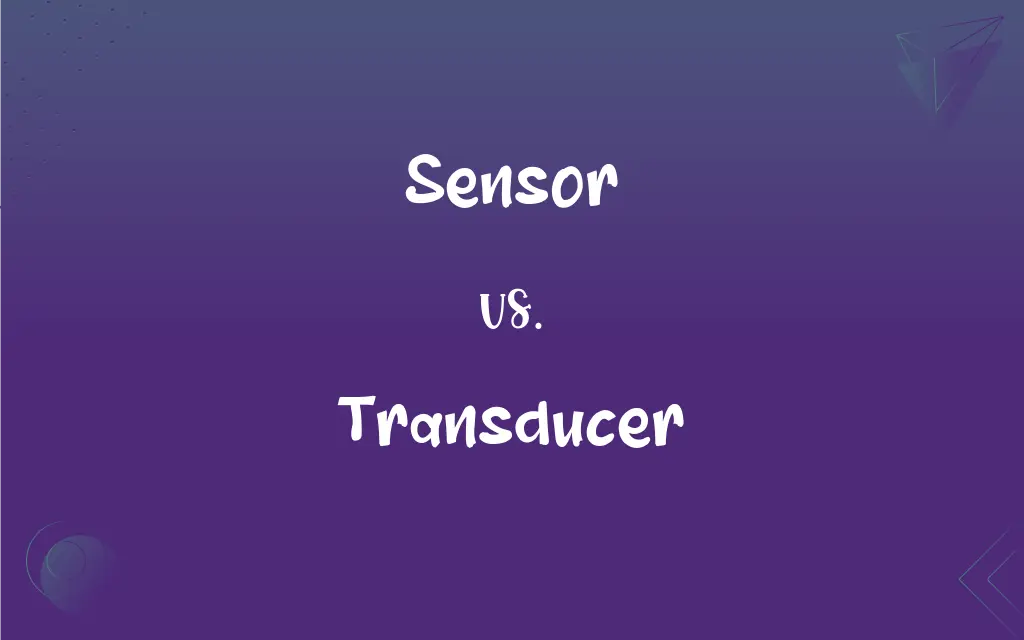Sensor vs. Transducer: What's the Difference?
Edited by Janet White || By Harlon Moss || Updated on October 27, 2023
A sensor detects physical changes or events, while a transducer converts energy from one form to another.

Key Differences
In the world of electronics and instrumentation, sensor and transducer are terms that are sometimes used interchangeably but have different meanings. A sensor is a device that recognizes and measures a physical property or phenomenon. In contrast, a transducer is an apparatus that changes energy from one form into another.
A sensor typically acts as an interface between a physical environment and an electronic circuit, picking up a specific input, such as temperature or light. On the other hand, a transducer does more than just detect; it actively converts the detected property into another energy type, often an electrical signal.
The distinction between a sensor and a transducer can sometimes be subtle. For instance, in a microphone, the sensor component detects sound waves, while the transducer element transforms these waves into electrical signals. However, the term transducer is broader in scope, encompassing devices that might not necessarily serve sensing functions.
While every sensor can be a transducer because it translates a physical property into a readable output, not every transducer is a sensor. Some transducers only serve the purpose of energy conversion without any sensing function.
To summarize, a sensor senses or detects physical properties, and a transducer converts forms of energy. The terms are closely related but distinct in their scope and function, with transducers often encompassing a broader range of devices than sensors.
ADVERTISEMENT
Comparison Chart
Primary Function
Detects physical properties or events.
Converts energy from one form to another.
Scope
Specific to sensing.
Broad, encompassing both sensing and energy conversion.
Output
Often an initial response to a detected property.
A converted form of the detected or input energy.
Example
Thermocouple detecting temperature.
Piezoelectric crystal converting pressure changes to electrical signals.
Usage in Systems
Acts as an interface between the environment and the system.
Can function both as an interface and an energy converter within a system.
ADVERTISEMENT
Sensor and Transducer Definitions
Sensor
Sensor is a device that detects physical properties.
The thermostat sensor detects room temperature.
Transducer
Transducer is an apparatus converting one form of energy to another.
A loudspeaker transducer converts electrical signals to sound.
Sensor
Sensor measures specific phenomena or events.
A light sensor measures the intensity of ambient light.
Transducer
Transducer serves a broader function than just sensing.
A motor transducer converts electrical energy into motion.
Sensor
Sensor acts as a bridge between physical and electronic realms.
A gas sensor in industrial setups identifies hazardous gas leaks.
Transducer
Transducer is integral in systems requiring energy transformations.
Ultrasonic transducers in medical imaging convert electrical pulses to sound waves and vice versa.
Sensor
Sensor can be passive or active based on its operation.
An infrared sensor passively detects emitted radiation from objects.
Transducer
Transducer encompasses both detection and conversion functions.
A microphone transducer detects sound and converts it to electrical signals.
Sensor
Sensor provides an output in response to a specific input.
A pressure sensor gives an output when pressure variations are sensed.
Transducer
Transducer can operate in multiple domains like mechanical, electrical, and acoustic.
A piezoelectric transducer transforms mechanical vibrations into electrical signals.
Sensor
A device, such as a photoelectric cell, that receives and responds to a signal or stimulus.
Transducer
(Physics) A substance or device, such as a piezoelectric crystal, microphone, or photoelectric cell, that converts input energy of one form into output energy of another.
FAQs
Where are sensors used?
Sensors are used in a variety of applications ranging from smartphones and household appliances to industrial machinery and aerospace.
What is a sensor?
A sensor is a device that detects or measures a physical property and records, indicates, or otherwise responds to it.
Can sensors wear out?
Yes, some sensors degrade over time and might require replacement or recalibration.
What is sensor calibration?
Sensor calibration ensures that a sensor's output corresponds accurately to the physical property it's measuring.
How do sensors work?
Sensors work by converting a physical phenomenon (like temperature, pressure, or light) into an electrical signal.
Do all sensors have a digital output?
No, sensors can produce analog or digital outputs, depending on their design.
What is a transducer?
A transducer is a device that converts one form of energy to another.
Where are transducers used?
Transducers are used in various applications like medical ultrasonography, microphones, and loudspeakers.
Are sensors active or passive?
Sensors can be either active (requiring external power to operate) or passive (no external power source required).
How accurate are sensors?
Sensor accuracy varies based on design and application. Some are highly precise, while others offer a broader range.
How is a transducer different from a sensor?
While both detect changes in physical properties, a sensor only responds to it, while a transducer actively converts it to another form of energy.
Do transducers require maintenance?
Yes, like other devices, transducers can require maintenance to ensure longevity and accuracy.
Can transducers be bi-directional?
Some transducers can operate bi-directionally, converting energy in two directions. For example, a microphone and speaker.
How do sensors communicate data?
Sensors can transmit data via wired or wireless connections, using protocols like I2C, SPI, or Bluetooth.
Are transducers always electronic?
No, while many transducers are electronic, others, like hydraulic or pneumatic transducers, are not.
What is the efficiency of a transducer?
Efficiency refers to how effectively a transducer converts input energy to output energy. It varies based on design and use.
What is a passive transducer?
A passive transducer requires an external power source for its operation, like a thermocouple.
How are transducers classified?
Transducers can be classified based on principles of operation (e.g., resistive, capacitive), energy types they deal with (e.g., electrical, mechanical), and more.
What are the common types of sensors?
Common types include temperature sensors, pressure sensors, proximity sensors, and light sensors.
What are common types of transducers?
Examples include piezoelectric transducers (convert mechanical to electrical energy) and loudspeakers (convert electrical energy to sound).
About Author
Written by
Harlon MossHarlon is a seasoned quality moderator and accomplished content writer for Difference Wiki. An alumnus of the prestigious University of California, he earned his degree in Computer Science. Leveraging his academic background, Harlon brings a meticulous and informed perspective to his work, ensuring content accuracy and excellence.
Edited by
Janet WhiteJanet White has been an esteemed writer and blogger for Difference Wiki. Holding a Master's degree in Science and Medical Journalism from the prestigious Boston University, she has consistently demonstrated her expertise and passion for her field. When she's not immersed in her work, Janet relishes her time exercising, delving into a good book, and cherishing moments with friends and family.































































